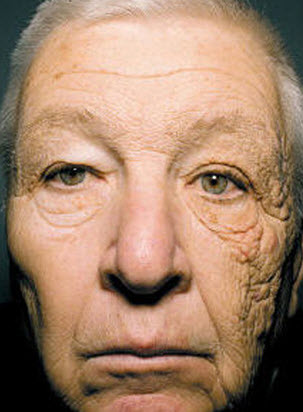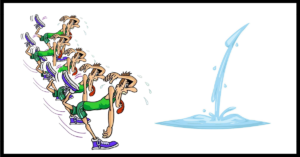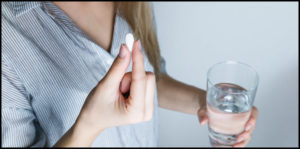
Think the sun doesn’t really do too much to your skin?
Think again! This picture of a 60 year old truckie from the US tells the story of years of exposure to the sun. Note his left side (exposed to the sun through the side window of his truck – they drive on a funny side of the road over there) is far more wrinkled than the right? That’s what years of sun exposure is doing to your skin!
None of us would willingly sign up for the wrinkles on the left side of this guy’s face, yet many of us (myself included) are taking less than fantastic care of our skin.
Here in Australia, we are all familiar with the Slip, Slop, Slap sun protection message, and with global warming, it’s even more important to heed the message.
The Cancer Council is thinking about using this photo to bring home the sun protection message. Incredible to think that we might be more likely to slip slop slap if we think it’s going to preserve our youthful good looks for longer, than if we thought it might help to prevent us from developing a melanoma!
This image is taken from the BoM website. It’s the UV index forecast for noon on Dec 8th in Sydney. An overcast day, of a fairly average temperature. The bits in purple indicate an extreme ultra violet index! So pretty much, if you’re anywhere in Australia, you need to be sure to protect yourself from the sun’s harmful rays!
If you’re a runner, walker, or a lover of outdoor exercise, it’s hard to escape the sun! Here are a few tips from the Cancer Council. You can find more info here.
Clothing
- One of the best barriers between skin and sun
- Long pants, long-sleeved collared shirts, covering as much of the body as possible.
- It absorbs and reflects the radiation that strikes the fabric.
- UPF ratings based on how much radiation passes through non-stretched, dry material
- UPF (the Ultra Violet Protection Factor) represents the factor by which UV exposure is reduced – eg UPF of 20 allows one twentieth of the UV radiation to pass through.
- UPF rating of 40 or higher offer good levels of protection – they block out at least 97.5% of UV radiation
- Clothing does not need to have a UPF rating to protect from UV.
- Ligthweight, closely woven, dark colours offer the best protection for non UPF-rated clothing
UPF ratings for clothing are based on how much radiation passed through
non-stretched, dry material
Sunscreen
- Go for SPF 30 or higher, broad spectrum, water resistant
- Sunscreens work by filtering UV radiation which are either inorganic or physical, or organic or chemical
- Inorganic filters are composed of minerals most commonly metal oxides titanium dioxide or zinc oxide – they screen both UVA and UVB
- Organic or chemical filters are composed of various compounds such as cinnamates (UVB filter), oxybenzone (UVA) and terephtalylidenedicamphor sulfonic acid (a UVA and UVB filter).
- Sunscreens based on inorganic or chemical filters don’t penetrate as deeply into the skin
- Sunscreen should be stored below 30C and not used past expiry date.
- Sunscreen should be used in conjunction with other sun protection such as staying in the shade, wearing covering clothing, a broad-brimmed hat and sunglasses.
SPF is only a measure of protection under idealised laboratory conditions and against UVB radiation. SPF does not take into account UVA
How To Apply Sunscreen
- The SPF of a sunscreen is determined as the ratio of time taken for a perceptible reddening of the skin to be seen., when 2mg/cm2 sunscreen is applied, in comparison to the time it takes the skin to redden without sunscreen.
- Properly applied, ie 2mg/cm2 of skin, SPF30 sunscreens filter out 96.7% of UVB, while SPF50 filters out 98%.
Most people apply far less sunscreen than is recommended by manufacturers. As a result, sunscreen users achieve an SPF of between 50-80% less than that specified on the product label.
- You should apply 2mg sunscreen to each square centimetre of exposed skin – about 35 ml per application for an adult, to reach the specified SPF.
- The Cancer Council recommends you apply a bit more than this (45mls) or the equivalent of a shot glass or golf ball. 9 teaspoons to the head face and neck, two teaspoons to the torso, on teaspoon to each arm/forearm and two teaspoons to each leg
- Apply 20 mins before going into the sun, then every 2 hours.
There’s no way I use that much sunscreen on my face, but having seen the truckie’s photo, I fully intend to now!!
Vitamin D
Although in theory suncreens could block the sun-induced production of pre-Vitamin D3,
in practice this is unlikely to happen, due to the inadequate application of sunscreen,
and incidental exposure when outdoors for only short periods unprotected
Shade
- Shade does not provide 100% protection. Some UV can be reflected off the surrounding surfaces
- Rule of thumb is if you can see the sky, you’re not fully protected.
- Combine with sunscreen, a broad brimmed hat and sunglasses
I clearly remember the whole family getting burnt last summer when we were high up in the stand at the cricket, and seemingly protected.
Sunglasses
- Use sunglasses year round
- The amount of UV reaching the eyes does not correlate well with UV levels, which measure UV reaching an unobstructed horizontal plane, and is instead highly dependent on unique geometry of the ocular region.
- Overexposure to UV radiation can cause short-term eye damage in the form of mild irritation, sunburn of the cornea, inflammation and excessive blinking
- Long term over exposure may lead to permanent damage such as squamous cell cancers on the conjunctiva, skin cancer around the eyes and eyelids, cataracts, macular degeneration, pterytium and cloudiness of the cornea.
- Wearing both a broad-brimmed hat and sunglasses that meet Australian Standard can reduce UV radiation exposure to the eyes by up to 98%.
- Were close fitting wrap around sunglasses, as 40% of UV gets to the eyes via peripheral light
References:
http://wiki.cancer.org.au/skincancerstats/Sun_protection




